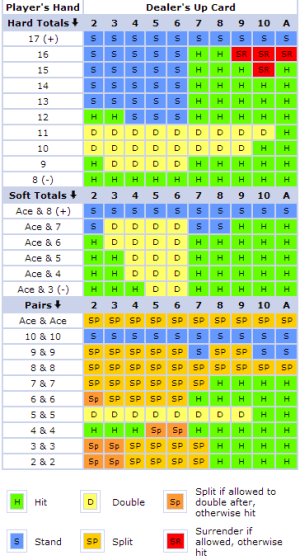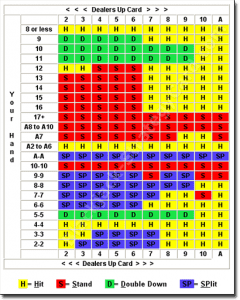When playing blackjack there are things you can do to make sure you optimise your chances of walking away from the table a winner. Mainly these optimisation skills are to do with decisions you make under certain circumstance. The blackjack strategy chart is a tool which can guide a player into making the decisions which give you the best odds of tasting success when playing 21.
When Dr. Edward O. Thorp first published Beat the Dealer, online blackjack did not exist so his optimal play strategies weren’t created with the Internet in mind. Lucky for us, players all around the globe who have been connected via the world wide web have created and shared strategy charts that have been tested by computers to ensure optimal play for standard blackjack titles.
Optimal Blackjack Strategy Most blackjack strategies are founded on logic and mathematics. This is one game that has more to do with skills and numbers rather than luck, superstitions or rituals. If your maths skills aren’t quite up to scratch, however, don’t fret.
Best online blackjack casinos
- Blackjack: Optimal Strategy Blackjack, a game of skill and strategy, is immensely popular among casino table players for its low house edge and the various possibilities it offers for lowering the house edge further. The blackjack player aims to lower the house edge as much as possible by making the right decisions at the right time.
- Basic strategy is just the rocket booster. It gets the shuttle high enough in the atmosphere for the shuttle to do the rest of the work. The rocket booster never makes it to space. You’ll need counting, deviations, true count conversions and betting strategy to actually beat the game of blackjack but that’s for later.

How to read the blackjack strategy chart
The most important key when using a blackjack strategy chart is you are reading it correctly as it tells you when to hit, stand, split, double, or surrender and if you mix these actions up and perform them at the wrong time you could lose when you potentially could’ve won.
Good strategy charts for blackjack are colour coded with letters standing for the action with a key to match. For example H stands for hit, S represents stand, P stands for split and so on. These could vary depending on what chart you’re using so read the key carefully.
The dealer’s card is generally along the horizontal axis while the player’s hand is along the vertical axis. There are sections dedicated to hard hands, soft hands, and splits. Each move recommended based on the player’s hand and the dealer’s hand has been created by statistics, but obviously there is still an element of luck.
There are two strategy charts, one for when the dealer hits on a soft 17 and one for when a dealer hits on a hard 17. It is imperative you know which rule variation you are playing when using these charts as there are moves that differ from one another depending on what the dealer does. There are also charts for other variations of blackjack, however these are less common.

If you are playing at a land-based casino where you can’t set the pace of the game, it might be best to memorise key moves instead of the entire chart, to keep it simple in your head. For example, players should hit if you have from five to eight for a hard hand and on 12 to 15 for a soft hand; double on a 10 if the dealer has two to nine with a hard hand and on 18 if the dealer has two to six on a soft hand; and finally never split fives, or 10s. These aren’t specific rules you need to learn, but it is better to take some moves from the chart than none if you can’t memorise them all.
Examples of optimal play in blackjack
While the strategy chart does not guarantee you will win if you choose to do the move it does mean you are playing at your best in terms of statistics. We mentioned above a few rules to possibly remember which are examples of optimal play, however we will give more depth to the following examples.
Hitting with a hard hand
If the dealer has anything from a two to an Ace, players should hit when they have anything from a four to an eight with a hard hand. When a player has a nine they should hit on any card the dealer may have but double down if they have a three to six if possible. These are just some of the possible examples of playing at your optimum when you have a hard hand. Again, the moves vary between the two charts.
Standing with a soft hand
With a soft hand it is recommended to stand for more possible combinations when the dealer hits on a soft 17, and less when the dealer stands on a soft 17. An example of this is when a dealer has a six and the player has a soft 19, with the rules that the dealer has to hit on a soft 17, it is recommended players double down if available. When the dealer stands on a soft 17 it is recommended the player stands. There are a few combinations where this occurs so it is important to know which chart you need.
When to split
As mentioned above it is suggested never to split fives or 10s. Splitting Aces and eights is a prime example of optimal blackjack play. It is also suggested to only split fours when the rule that you can split after doubling is in place but this only applies when the dealer has a four or a five.
This isn’t all of the examples possible, rather it is just a select few so it is best you view the chart and try it out for yourself.
Can I practice my blackjack strategy for free?

All our recommended online casinos offer a free play mode so players can open up the strategy chart in a tab and try out the moves. Once you are ready to play with real money just change modes, make a deposit and you can get going. The best thing about playing online whether you are in free mode or not is that you can take your time. At land-based casinos and live dealer versions, there is a set pace, and a set amount of time to make bets. When you are first learning to use the strategy chart, it is best to take your time so we believe playing online is the best option.
Real money blackjack websites
When you’re looking for a real money website to play 21 games at it is important to take several factors into consideration. It’s also very important to play at online casinos which are governed in a trusted location like the United Kingdom, Malta or Curacao, which are two of the online licensing bodies with strong reputations.
Generally casinos we endorse to international players are approved by eCOGRA which is an independent auditing organisation, based out of the UK.
If you visit a casino and there are not many deposit options, you should steer clear of playing there because there are better options available, catering to several currencies and payment methods.

Blackjack, a game of skill and strategy, is immensely popular among casino table players for its low house edge and the various possibilities it offers for lowering the house edge further.
The blackjack player aims to lower the house edge as much as possible by making the right decisions at the right time.
A lot of players fail to win at blackjack because they do not know how to implement the proper blackjack strategies at the appropriate time.
Play blackjack at these great casinos:
| Rank | Casino | Bonus | Rating | Visit |
|---|---|---|---|---|
| 1 | 100% bonus + 20 free spins Book of Dead | Review | ||
| 2 | 100% bonus up to $€100 | Review | ||
| 3 | 100% bonus up to $150 + 100 free spins | Review | ||
| 4 | 100% bonus up to $100 + 150 free spins | Review | ||
| 5 | 100% bonus up to $300 + 70 free spins | Review |
Basic blackjack strategy
Basic blackjack strategy is something that players must learn as soon as they have learned the rules of the game. Basic strategy charts, which are available free of charge at most blackjack portals, tell players exactly what they should do in almost every situation they face while playing the game.
Best Blackjack Strategy Book
If players cannot memorise it, they can refer to it now and then while playing a game of blackjack.
Understanding blackjack terms
Blackjack Trainer Learn Optimal Strategy
Another major mistake that new players make is omitting to learn blackjack terms. Players should not only learn the rules, but understand correctly what is meant by hitting, standing, insurance, doubling down, surrendering, and so on.
There is not much sense in playing blackjack if players do not understand the basics.
Before playing blackjack, players should also know what is meant by hard hands, which are hands that do not contain an ace, and soft hands, which are hands that contain an ace.
It also helps to know some basic blackjack strategies as follows:

Splitting
• Avoid splitting tens, fives, and fours, but always split eights and aces.
• Sevens, threes, and twos can be split only if the dealer’s exposed card is seven or lower.
• Sixes can be split if the dealer’s exposed card is six or lower.
• Nines can be split if the dealer’s exposed card is an ace, ten, or seven.
• Some blackjack variants permit re-splitting hands if they get another same-value hand.
Doubling
• Players can double their bets if they have got a hand of point value 11
• Double a five pair unless the dealer’s exposed card is an ace or a ten
• Double a hand of point value nine only if the dealer’s exposed card is six or lower
Surrender
Some casinos allow players to surrender if they have a weak hand and get back half of their bet amounts. Players are sometimes overeager to surrender to save some of their money, as a result of which they even surrender good hands.
Players should never surrender on:
• Hands of point value 15 if the dealer’s exposed card is ace, ten, or nine
• Hands of point value 16 if the dealer’s exposed card is a nine
• Hands of point value 17 if the dealer’s exposed card is an ace, ten, or nine.
Insurance
Blackjack Optimal Strategy Odds
The insurance bet is a bet that a lot of inexperienced blackjack player seems to like. It is also a lousy strategy bet.
If the dealer’s face up card is an ace, the player is offered the option of taking an “insurance” bet of up to half the original wager before the dealer checks the hole card.
Insurance is a side bet (independent of the main wager) that the dealer has blackjack. The insurance bet, though it may seem attractive at first, feeds the fear of the player and has a very high house edge.
Never take insurance.
Educate yourself: become a better blackjack player
One’s blackjack education never ends. There is no shortage of blackjack strategy books for players to read, and players should make it a point to learn and practice as much as possible if they want blackjack success.
And never forget, the object of playing blackjack is not to come as close to 21 without busting. The purpose is to beat the dealer!